Padmanaban
Visit to download the full and correct content document: https://ebookmass.com/product/artificial-intelligence-based-smart-power-systems-1stedition-sanjeevikumar-padmanaban/
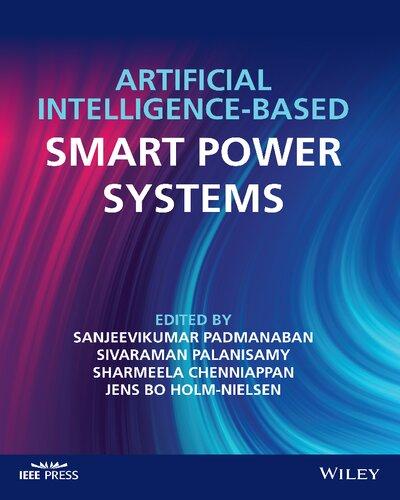
More products digital (pdf, epub, mobi) instant download maybe you interests ...

Residential Microgrids and Rural Electrifications
Sanjeevikumar Padmanaban
https://ebookmass.com/product/residential-microgrids-and-ruralelectrifications-sanjeevikumar-padmanaban/
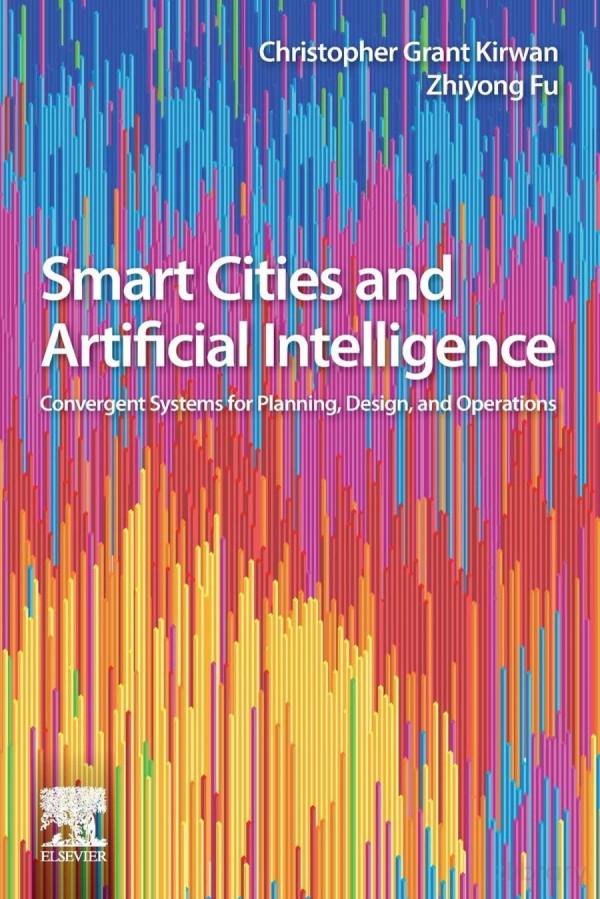
Smart Cities and Artificial Intelligence: Convergent Systems for Planning, Design, and Operations 1st Edition Christopher Grant Kirwan
https://ebookmass.com/product/smart-cities-and-artificialintelligence-convergent-systems-for-planning-design-andoperations-1st-edition-christopher-grant-kirwan/
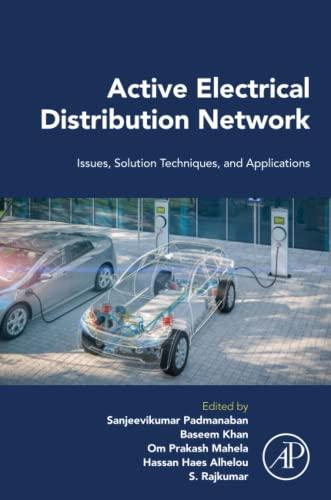
Active Electrical Distribution Network: Issues, Solution Techniques, and Applications Sanjeevikumar Padmanaban
https://ebookmass.com/product/active-electrical-distributionnetwork-issues-solution-techniques-and-applicationssanjeevikumar-padmanaban/
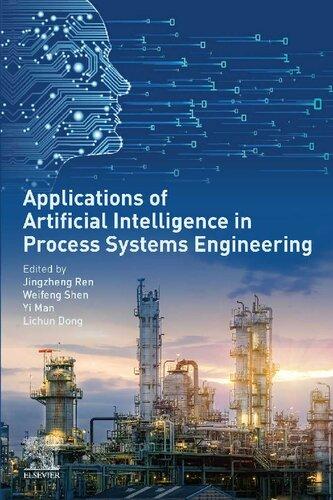
Applications of Artificial Intelligence in Process Systems Engineering Jingzheng Ren
https://ebookmass.com/product/applications-of-artificialintelligence-in-process-systems-engineering-jingzheng-ren/
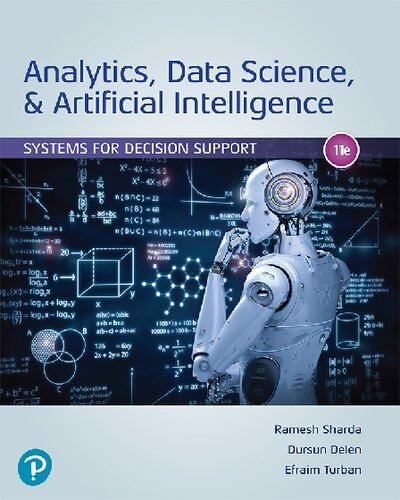
Analytics, data science, & artificial intelligence : systems for decision support Eleventh Edition Dursun Delen
https://ebookmass.com/product/analytics-data-science-artificialintelligence-systems-for-decision-support-eleventh-editiondursun-delen/
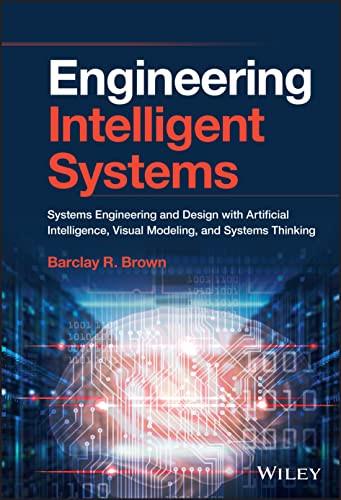
Engineering Intelligent Systems: Systems Engineering and Design with Artificial Intelligence, Visual Modeling Barclay R. Brown
https://ebookmass.com/product/engineering-intelligent-systemssystems-engineering-and-design-with-artificial-intelligencevisual-modeling-barclay-r-brown/

Artificial Intelligence for Dummies 2nd Edition John Paul Mueller & Luca Massaron
https://ebookmass.com/product/artificial-intelligence-fordummies-2nd-edition-john-paul-mueller-luca-massaron/

The Psychoanalysis of Artificial Intelligence 1st Edition Isabel Millar
https://ebookmass.com/product/the-psychoanalysis-of-artificialintelligence-1st-edition-isabel-millar/
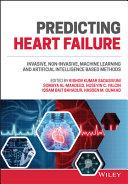
Predicting Heart Failure : Invasive, Non-Invasive, Machine Learning, and Artificial Intelligence Based Methods 1st Edition Kishor Kumar Sadasivuni
https://ebookmass.com/product/predicting-heart-failure-invasivenon-invasive-machine-learning-and-artificial-intelligence-basedmethods-1st-edition-kishor-kumar-sadasivuni/
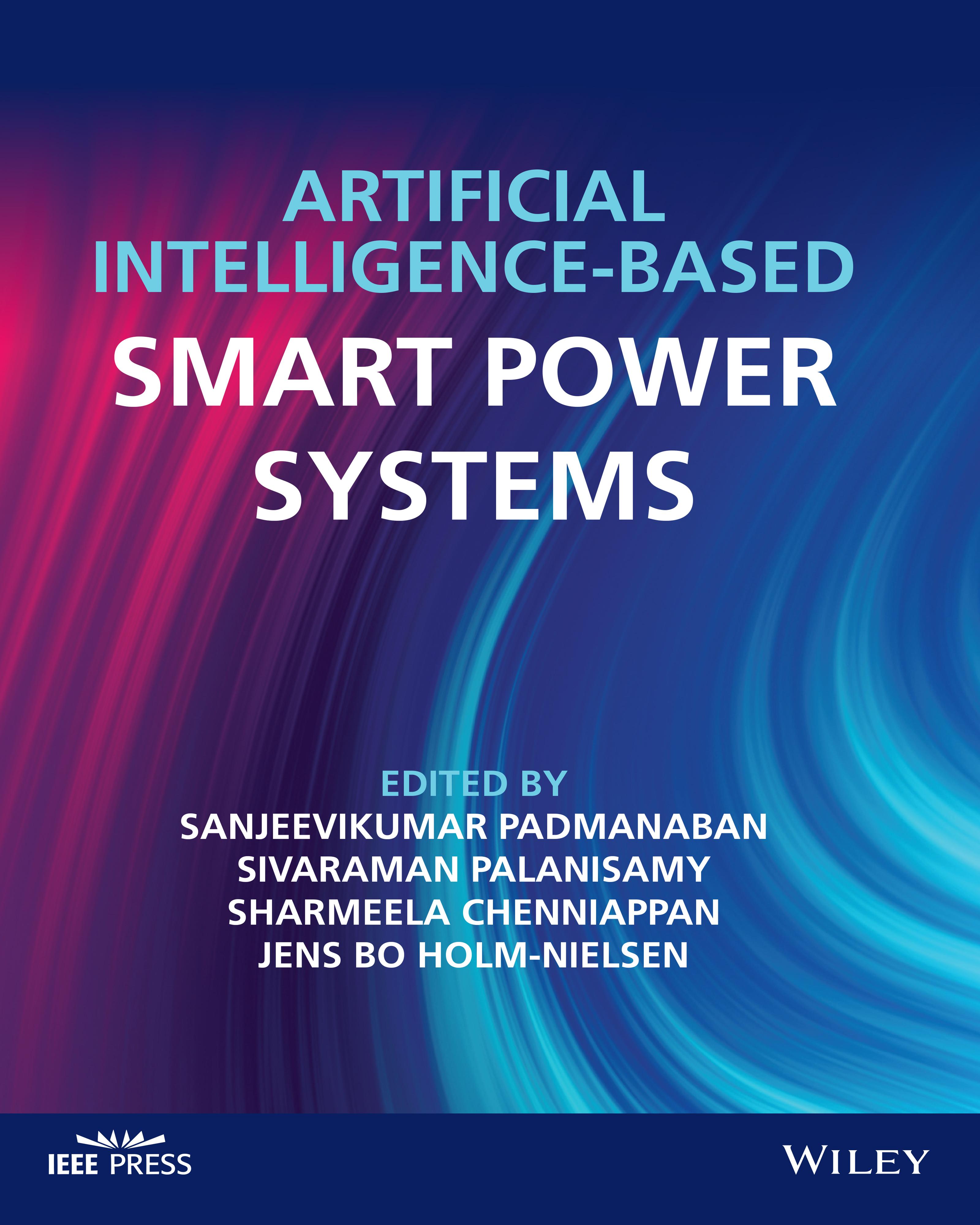
IEEEPress
445HoesLane Piscataway,NJ08854
IEEEPressEditorialBoard
SarahSpurgeon, EditorinChief
JónAtliBenediktsson
AnjanBose
AdamDrobot
Peter(Yong)Lian
AndreasMolisch
SaeidNahavandi
JeffreyReed
ThomasRobertazzi
DiomidisSpinellis
AhmetMuratTekalp
ArtificialIntelligence-basedSmartPowerSystems
Editedby
SanjeevikumarPadmanaban
DepartmentofElectricalEngineering,InformationTechnology,andCybernetics, UniversityofSouth-EasternNorway,Porsgrunn,Norway
SivaramanPalanisamy
WorldResourcesInstitute(WRI)India,Bengaluru,India
SharmeelaChenniappan
DepartmentofElectricalandElectronicsEngineering,AnnaUniversity,Chennai,India
JensBoHolm-Nielsen
DepartmentofEnergyTechnology,AalborgUniversity,Aalborg,Denmark
Copyright©2023byTheInstituteofElectricalandElectronicsEngineers,Inc.Allrightsreserved.
PublishedbyJohnWiley&Sons,Inc.,Hoboken,NewJersey. PublishedsimultaneouslyinCanada.
Nopartofthispublicationmaybereproduced,storedinaretrievalsystem,ortransmittedinanyformorbyanymeans,electronic, mechanical,photocopying,recording,scanning,orotherwise,exceptaspermittedunderSection107or108ofthe1976UnitedStates CopyrightAct,withouteitherthepriorwrittenpermissionofthePublisher,orauthorizationthroughpaymentoftheappropriate per-copyfeetotheCopyrightClearanceCenter,Inc.,222RosewoodDrive,Danvers,MA01923,(978)750-8400,fax(978)750-4470,or onthewebatwww.copyright.com.RequeststothePublisherforpermissionshouldbeaddressedtothePermissionsDepartment, JohnWiley&Sons,Inc.,111RiverStreet,Hoboken,NJ07030,(201)748-6011,fax(201)748-6008,oronlineat http://www.wiley.com/go/permission.
LimitofLiability/DisclaimerofWarranty:Whilethepublisherandauthorhaveusedtheirbesteffortsinpreparingthisbook,they makenorepresentationsorwarrantieswithrespecttotheaccuracyorcompletenessofthecontentsofthisbookandspecifically disclaimanyimpliedwarrantiesofmerchantabilityorfitnessforaparticularpurpose.Nowarrantymaybecreatedorextendedby salesrepresentativesorwrittensalesmaterials.Theadviceandstrategiescontainedhereinmaynotbesuitableforyoursituation.You shouldconsultwithaprofessionalwhereappropriate.Neitherthepublishernorauthorshallbeliableforanylossofprofitorany othercommercialdamages,includingbutnotlimitedtospecial,incidental,consequential,orotherdamages.Further,readersshould beawarethatwebsiteslistedinthisworkmayhavechangedordisappearedbetweenwhenthisworkwaswrittenandwhenitisread. Neitherthepublishernorauthorsshallbeliableforanylossofprofitoranyothercommercialdamages,includingbutnotlimitedto special,incidental,consequential,orotherdamages.
Forgeneralinformationonourotherproductsandservicesorfortechnicalsupport,pleasecontactourCustomerCareDepartment withintheUnitedStatesat(800)762-2974,outsidetheUnitedStatesat(317)572-3993orfax(317)572-4002.
Wileyalsopublishesitsbooksinavarietyofelectronicformats.Somecontentthatappearsinprintmaynotbeavailableinelectronic formats.FormoreinformationaboutWileyproducts,visitourwebsiteatwww.wiley.com.
LibraryofCongressCataloging-in-PublicationDataAppliedfor:
HardbackISBN:9781119893967
CoverDesign:Wiley
CoverImage:©EkaterinaGoncharova/GettyImages
Setin9.5/12.5ptSTIXTwoTextbyStraive,Chennai,India
Contents
EditorBiography xv ListofContributors xvii
1IntroductiontoSmartPowerSystems 1
SivaramanPalanisamy,ZahiraRahiman,andSharmeelaChenniappan
1.1ProblemsinConventionalPowerSystems 1
1.2DistributedGeneration(DG) 1
1.3WideAreaMonitoringandControl 2
1.4AutomaticMeteringInfrastructure 4
1.5PhasorMeasurementUnit 6
1.6PowerQualityConditioners 8
1.7EnergyStorageSystems 8
1.8SmartDistributionSystems 9
1.9ElectricVehicleChargingInfrastructure 10
1.10CyberSecurity 11
1.11Conclusion 11 References 11
2ModelingandAnalysisofSmartPowerSystem 15
MadhuPalati,SagarSinghPrathap,andNageshHalasahalliNagaraju
2.1Introduction 15
2.2ModelingofEquipment’sforSteady-StateAnalysis 16
2.2.1LoadFlowAnalysis 16
2.2.1.1GaussSeidelMethod 18
2.2.1.2NewtonRaphsonMethod 18
2.2.1.3DecoupledLoadFlowMethod 18
2.2.2ShortCircuitAnalysis 19
2.2.2.1SymmetricalFaults 19
2.2.2.2UnsymmetricalFaults 20
2.2.3HarmonicAnalysis 20
2.3ModelingofEquipmentsforDynamicandStabilityAnalysis 22
2.4DynamicAnalysis 24
2.4.1FrequencyControl 24
2.4.2FaultRideThrough 26
2.5VoltageStability 26
2.6CaseStudies 27
2.6.1CaseStudy1 27
2.6.2CaseStudy2 28
2.6.2.1ExistingandProposedGenerationDetailsintheVicinityofWindFarm 29
2.6.2.2PowerEvacuationStudyfor50MWGeneration 30
2.6.2.3WithoutInterconnectionoftheProposed50MWGenerationfromWindFarmon66kVLevelof220/66kV Substation 31
2.6.2.4ObservationsMadefromTable2.6 31
2.6.2.5WiththeInterconnectionofProposed50MWGenerationfromWindFarmon66kVlevelof220/66kV Substation 31
2.6.2.6NormalConditionwithoutConsideringContingency 32
2.6.2.7ContingencyAnalysis 32
2.6.2.8WiththeInterconnectionofProposed60MWGenerationfromWindFarmon66kVLevelof220/66kV Substation 33
2.7Conclusion 34 References 34
3MultilevelCascadedBoostConverterFedMultilevelInverterforRenewableEnergy Applications 37
MarimuthuMarikannu,VijayalakshmiSubramanian,ParanthaganBalasubramanian,JayakumarNarayanasamy, NishaC.Rani,andDeviVigneshwariBalasubramanian
3.1Introduction 37
3.2MultilevelCascadedBoostConverter 40
3.3ModesofOperationofMCBC 42
3.3.1Mode-1SwitchSA IsON 42
3.3.2Mode-2SwitchSA IsON 42
3.3.3Mode-3-Operation–SwitchSA IsON 42
3.3.4Mode-4-Operation–SwitchSA IsON 42
3.3.5Mode-5-Operation–SwitchSA IsON 42
3.3.6Mode-6-Operation–SwitchSA IsOFF 42
3.3.7Mode-7-Operation–SwitchSA IsOFF 42
3.3.8Mode-8-Operation–SwitchSA IsOFF 43
3.3.9Mode-9-Operation–SwitchSA IsOFF 44
3.3.10Mode10-Operation–SwitchSA isOFF 45
3.4SimulationandHardwareResults 45
3.5ProminentStructuresofEstimatedDC–DCConverterwithPrevailingConverter 49
3.5.1VoltageGainandPowerHandlingCapability 49
3.5.2VoltageStress 49
3.5.3SwitchCountandGeometricStructure 49
3.5.4CurrentStress 52
3.5.5DutyCycleVersusVoltageGain 52
3.5.6NumberofLevelsinthePlannedConverter 52
3.6PowerElectronicConvertersforRenewableEnergySources(ApplicationsofMLCB) 54
3.6.1MCBCConnectedwithPVPanel 54
3.6.2OutputResponseofPVFedMCBC 54
3.6.3H-BridgeInverter 54
3.7ModesofOperation 55
3.7.1Mode1 55
3.7.2Mode2 55
3.7.3Mode3 56
3.7.4Mode4 56
3.7.5Mode5 56
3.7.6Mode6 56
3.7.7Mode7 58
3.7.8Mode8 58
3.7.9Mode9 59
3.7.10Mode10 59
3.8SimulationResultsofMCBCFedInverter 60
3.9PowerElectronicConverterforE-Vehicles 61
3.10PowerElectronicConverterforHVDC/Facts 62
3.11Conclusion 63 References 63
4RecentAdvancementsinPowerElectronicsforModernPowerSystems-ComprehensiveReview onDC-LinkCapacitorsConcerningPowerDensityMaximizationinPowerConverters 65 NaveenkumarMarati,ShariqAhammed,KathirvelKaruppazaghi,BalrajVaithilingam,GyanR.Biswal, PhaneendraB.Bobba,SanjeevikumarPadmanaban,andSharmeelaChenniappan
4.1Introduction 65
4.2ApplicationsofPowerElectronicConverters 66
4.2.1PowerElectronicConvertersinElectricVehicleEcosystem 66
4.2.2PowerElectronicConvertersinRenewableEnergyResources 67
4.3ClassificationofDC-LinkTopologies 68
4.4BriefingonDC-LinkTopologies 69
4.4.1PassiveCapacitiveDCLink 69
4.4.1.1FilterTypePassiveCapacitiveDCLinks 70
4.4.1.2FilterTypePassiveCapacitiveDCLinkswithControl 72
4.4.1.3InterleavedTypePassiveCapacitiveDCLinks 74
4.4.2ActiveBalancinginCapacitiveDCLink 75
4.4.2.1SeparateAuxiliaryActiveCapacitiveDCLinks 76
4.4.2.2IntegratedAuxiliaryActiveCapacitiveDCLinks 78
4.5ComparisononDC-LinkTopologies 82
4.5.1ComparisonofPassiveCapacitiveDCLinks 82
4.5.2ComparisonofActiveCapacitiveDCLinks 83
4.5.3ComparisonofDCLinkBasedonPowerDensity,Efficiency,andRippleAttenuation 86
4.6FutureandResearchGapsinDC-LinkTopologieswithBalancingTechniques 94
4.7Conclusion 95 References 95
5EnergyStorageSystemsforSmartPowerSystems 99
SivaramanPalanisamy,LogeshkumarShanmugasundaram,andSharmeelaChenniappan
5.1Introduction 99
5.2EnergyStorageSystemforLowVoltageDistributionSystem 100
5.3EnergyStorageSystemConnectedtoMediumandHighVoltage 101
5.4EnergyStorageSystemforRenewablePowerPlants 104
5.4.1RenewablePowerEvacuationCurtailment 106
5.5TypesofEnergyStorageSystems 109
5.5.1BatteryEnergyStorageSystem 109
5.5.2ThermalEnergyStorageSystem 110
5.5.3MechanicalEnergyStorageSystem 110
5.5.4PumpedHydro 110
5.5.5HydrogenStorage 110
5.6EnergyStorageSystemsforOtherApplications 111
5.6.1ShiftinEnergyTime 111
5.6.2VoltageSupport 111
5.6.3FrequencyRegulation(Primary,Secondary,andTertiary) 112
5.6.4CongestionManagement 112
5.6.5BlackStart 112
5.7Conclusion 112 References 113
6Real-TimeImplementationandPerformanceAnalysisofSupercapacitorforEnergyStorage 115 ThamatapuEswararao,SundaramElango,UmashankarSubramanian,KrishnamohanTatikonda, GarikaGantaiahswamy,andSharmeelaChenniappan
6.1Introduction 115
6.2StructureofSupercapacitor 117
6.2.1MathematicalModelingofSupercapacitor 117
6.3BidirectionalBuck–BoostConverter 118
6.3.1FPGAController 119
6.4ExperimentalResults 120
6.5Conclusion 123 References 125
7AdaptiveFuzzyLogicControllerforMPPTControlinPMSGWindTurbineGenerator 129 RaniaMoutchou,AhmedAbbou,BouazzaJabri,SalahE.Rhaili,andKhalidChigane
7.1Introduction 129
7.2ProposedMPPTControlAlgorithm 130
7.3WindEnergyConversionSystem 131
7.3.1WindTurbineCharacteristics 131
7.3.2ModelofPMSG 132
7.4FuzzyLogicCommandfortheMPPTofthePMSG 133
7.4.1Fuzzification 134
7.4.2FuzzyLogicRules 134
7.4.3Defuzzification 134
7.5ResultsandDiscussions 135
7.6Conclusion 139 References 139
8ANovelNearestNeighborSearching-BasedFaultDistanceLocationMethodforHVDC TransmissionLines 141 AleenaSwetapadma,ShobhaAgarwal,SatarupaChakrabarti,andSohamChakrabarti
8.1Introduction 141
8.2NearestNeighborSearching 142
8.3ProposedMethod 144
8.3.1PowerSystemNetworkUnderStudy 144
8.3.2ProposedFaultLocationMethod 145
8.4Results 146
8.4.1PerformanceVaryingNearestNeighbor 147
8.4.2PerformanceVaryingDistanceMatrices 147
8.4.3NearBoundaryFaults 148
8.4.4FarBoundaryFaults 149
8.4.5PerformanceDuringHighResistanceFaults 149
8.4.6SinglePoletoGroundFaults 150
8.4.7PerformanceDuringDoublePoletoGroundFaults 151
8.4.8PerformanceDuringPoletoPoleFaults 151
8.4.9ErrorAnalysis 152
8.4.10ComparisonwithOtherSchemes 153
8.4.11AdvantagesoftheScheme 154
8.5Conclusion 154 Acknowledgment 154 References 154
9ComparativeAnalysisofMachineLearningApproachesinEnhancingPowerSystem
Stability 157
Md.I.H.Pathan,MohammadS.Shahriar,MohammadM.Rahman,Md.SanwarHossain,NadiaAwatif,and Md.Shafiullah
9.1Introduction 157
9.2PowerSystemModels 159
9.2.1PSSIntegratedSingleMachineInfiniteBusPowerNetwork 159
9.2.2PSS-UPFCIntegratedSingleMachineInfiniteBusPowerNetwork 160 9.3Methods 161
9.3.1GroupMethodDataHandlingModel 161
9.3.2ExtremeLearningMachineModel 162
9.3.3NeurogeneticModel 162
9.3.4MultigeneGeneticProgrammingModel 163
9.4DataPreparationandModelDevelopment 165
9.4.1DataProductionandProcessing 165
9.4.2MachineLearningModelDevelopment 165
9.5ResultsandDiscussions 166
9.5.1EigenvaluesandMinimumDampingRatioComparison 166
9.5.2Time-DomainSimulationResultsComparison 170
9.5.2.1RotorAngleVariationUnderDisturbance 170
9.5.2.2RotorAngularFrequencyVariationUnderDisturbance 171
9.5.2.3DC-LinkVoltageVariationUnderDisturbance 173
9.6Conclusions 173 References 174
10AugmentationofPV-WindHybridTechnologywithAdroitNeuralNetwork,ANFIS,andPI ControllersIndeedPrecociousDVRSystem 179 JyotiShukla,BasantaK.Panigrahi,andMonikaVardia
10.1Introduction 179
10.2PV-WindHybridPowerGenerationConfiguration 180
10.3ProposedSystemsTopologies 181
10.3.1StructureofPVSystem 181
10.3.2TheMPPTsTechnique 183
10.3.3NNPredictiveControllerTechnique 183
10.3.4ANFISTechnique 184
10.3.5TrainingData 186
10.4WindPowerGenerationPlant 187
10.5PitchAngleControlTechniques 189
10.5.1PIController 189
10.5.2NARMA-L2Controller 190
10.5.3FuzzyLogicControllerTechnique 192
10.6ProposedDVRsTopology 192
10.7ProposedControllingTechniqueofDVR 193
10.7.1ANFISandPIControllingTechnique 193
10.8ResultsoftheProposedTopologies 196
10.8.1PVSystemOutputs(MPPTTechniquesResults) 196
10.8.2MainPVSystemoutputs 196
10.8.3WindTurbineSystemOutputs(PitchAngleControlTechniqueResult) 198
10.8.4ProposedPMSGWindTurbineSystemOutput 199
10.8.5PerformanceofDVR(ControllingTechniqueResults) 203
10.8.6DVRsPerformance 203
10.9Conclusion 204 References 204
11DeepReinforcementLearningandEnergyPricePrediction 207
DeepakYadav,SaadMekhilef,BrijeshSingh,andMuhyaddinRawa Abbreviations 207
11.1Introduction 208
11.2DeepandReinforcementLearningforDecision-MakingProblemsinSmartPowerSystems 210
11.2.1ReinforcementLearning 210
11.2.1.1MarkovDecisionProcess(MDP) 210
11.2.1.2ValueFunctionandOptimalPolicy 211
11.2.2ReinforcementLearningstoDeepReinforcementLearnings 212
11.2.3DeepReinforcementLearningAlgorithms 212
11.3ApplicationsinPowerSystems 213
11.3.1EnergyManagement 213
11.3.2PowerSystems’DemandResponse(DR) 215
11.3.3ElectricityMarket 216
11.3.4OperationsandControls 217
11.4MathematicalFormulationofObjectiveFunction 218
11.4.1LocationalMarginalPrices(LMPs)Representation 219
11.4.2RelativeStrengthIndex(RSI) 219
11.4.2.1AutoregressiveIntegratedMovingAverage(ARIMA) 219
11.5Interior-pointTechnique&KKTCondition 220
11.5.1ExplanationofKarush–Kuhn–TuckerConditions 220
11.5.2AlgorithmforFindingaSolution 221
11.6TestResultsandDiscussion 221
11.6.1IllustrativeExample 221
11.7ComparativeAnalysiswithOtherMethods 223
11.8Conclusion 224
11.9Assignment 224 Acknowledgment 225 References 225
12PowerQualityConditionersinSmartPowerSystem 233
ZahiraRahiman,LakshmiDhandapani,RaviChengalvarayanNatarajan,PramilaVallikannan, SivaramanPalanisamy,andSharmeelaChenniappan
12.1Introduction 233
12.1.1VoltageSag 234
12.1.2VoltageSwell 234
12.1.3Interruption 234
12.1.4UnderVoltage 234
12.1.5Overvoltage 234
12.1.6VoltageFluctuations 234
12.1.7Transients 235
12.1.8ImpulsiveTransients 235
12.1.9OscillatoryTransients 235
12.1.10Harmonics 235
12.2PowerQualityConditioners 235
12.2.1STATCOM 235
12.2.2SVC 235
12.2.3HarmonicFilters 236
12.2.3.1ActiveFilter 236
12.2.4UPSSystems 236
12.2.5DynamicVoltageRestorer(DVR) 236
12.2.6EnhancementofVoltageSag 236
12.2.7InterruptionMitigation 237
12.2.8MitigationofHarmonics 241
12.3StandardsofPowerQuality 244
12.4SolutionforPowerQualityIssues 244
12.5SustainableEnergySolutions 245
12.6NeedforSmartGrid 245
12.7WhatIsaSmartGrid? 245
12.8SmartGrid:The“EnergyInternet” 245
12.9Standardization 246
12.10SmartGridNetwork 247
12.10.1DistributedEnergyResources(DERs) 247
12.10.2OptimizationTechniquesinPowerQualityManagement 247
12.10.3ConventionalAlgorithm 248
12.10.4IntelligentAlgorithm 248
12.10.4.1FireflyAlgorithm(FA) 248
12.10.4.2SpiderMonkeyOptimization(SMO) 250
12.11SimulationResultsandDiscussion 254
12.12Conclusion 257 References 257
13TheRoleofInternetofThingsinSmartHomes 259
SanjeevikumarPadmanaban,MostafaAzimiNasab,MohammadEbrahimShiri,HamidHajSeyyedJavadi, MortezaAzimiNasab,MohammadZand,andTinaSamavat
13.1Introduction 259
13.2InternetofThingsTechnology 260
13.2.1SmartHouse 261
13.3DifferentPartsofSmartHome 262
13.4ProposedArchitecture 264
13.5ControllerComponents 265
13.6ProposedArchitecturalLayers 266
13.6.1InfrastructureLayer 266
13.6.1.1InformationTechnology 266
13.6.1.2InformationandCommunicationTechnology 266
13.6.1.3Electronics 266
13.6.2CollectingData 267
13.6.3DataManagementandProcessing 267
13.6.3.1ServiceQualityManagement 267
13.6.3.2ResourceManagement 267
13.6.3.3DeviceManagement 267
13.6.3.4Security 267
13.7Services 267
13.8Applications 268
13.9Conclusion 269 References 269
14ElectricVehiclesandIoTinSmartCities 273
SanjeevikumarPadmanaban,TinaSamavat,MostafaAzimiNasab,MortezaAzimiNasab,MohammadZand,and FatemehNikokar
14.1Introduction 273
14.2SmartCity 275
14.2.1InternetofThingsandSmartCity 275
14.3TheConceptofSmartElectricNetworks 275
14.4IoTOutlook 276
14.4.1IoTThree-layerArchitecture 276
14.4.2ViewLayer 276
14.4.3NetworkLayer 277
14.4.4ApplicationLayer 278
14.5IntelligentTransportationandTransportation 278
14.6InformationManagement 278
14.6.1ArtificialIntelligence 278
14.6.2MachineLearning 279
14.6.3ArtificialNeuralNetwork 279
14.6.4DeepLearning 280
14.7ElectricVehicles 281
14.7.1DefinitionofVehicle-to-NetworkSystem 281
14.7.2ElectricCarsandtheElectricityMarket 281
14.7.3TheRoleofElectricVehiclesintheNetwork 282
14.7.4V2GApplicationsinPowerSystem 282
14.7.5ProvideBaseloadPower 283
14.7.6CourierSupply 283
14.7.7ExtraService 283
14.7.8PowerAdjustment 283
14.7.9RotatingReservation 284
14.7.10TheConnectionbetweentheElectricVehicleandthePowerGrid 284
14.8ProposedModelofElectricVehicle 284
14.9PredictionUsingLSTMTimeSeries 285
14.9.1LSTMTimeSeries 286
14.9.2PredictingtheBehaviorofElectricVehiclesUsingtheLSTMMethod 287
14.10Conclusion 287 Exercise 288 References 288
15ModelingandSimulationofSmartPowerSystemsUsingHIL 291
GunapriyaDevarajan,PuspalathaNaveenKumar,MunirajChinnusamy,SabareeshwaranKanagaraj, andSharmeelaChenniappan
15.1Introduction 291
15.1.1ClassificationofHardwareintheLoop 291
15.1.1.1SignalHILModel 291
15.1.1.2PowerHILModel 292
15.1.1.3Reduced-ScaledHILModel 292
15.1.2PointstoBeConsideredWhilePerformingHILSimulation 293
15.1.3ApplicationsofHIL 293
15.2WhyHILIsImportant? 293
15.2.1Hardware-In-The-LoopSimulation 294
15.2.2SimulationVerificationandValidation 295
15.2.3SimulationComputerHardware 295
15.2.4BenefitsofUsingHardware-In-The-LoopSimulation 296
15.3HILforRenewableEnergySystems(RES) 296
15.3.1Introduction 296
15.3.2HardwareintheLoop 297
15.3.2.1ElectricalHardwareintheLoop 297
15.3.2.2MechanicalHardwareintheLoop 297
15.4HILforHVDCandFACTS 299
15.4.1Introduction 299
15.4.2ModularMultiLevelConverter 300
15.5HILforElectricVehicles 301
15.5.1Introduction 301
15.5.2EVSimulationUsingMATLAB,Simulink 302
15.5.2.1Model-BasedSystemEngineering(MBSE) 302
15.5.2.2ModelBatteriesandDevelopBMS 302
15.5.2.3ModelFuelCellSystems(FCS)andDevelopFuelCellControlSystems(FCCS) 303
15.5.2.4ModelInverters,TractionMotors,andDevelopMotorControlSoftware 304
15.5.2.5Deploy,Integrate,andTestControlAlgorithms 304
15.5.2.6Data-DrivenWorkflowsandAIinEVDevelopment 305
15.6HILforOtherApplications 306
15.6.1ElectricalMotorFaults 306
15.7Conclusion 307 References 308
16DistributionPhasorMeasurementUnits(PMUs)inSmartPowerSystems 311 GeethanjaliMuthiah,MeenakshiDeviManivannan,HemavathiRamadoss,andSharmeelaChenniappan
16.1Introduction 311
16.2ComparisonofPMUsandSCADA 312
16.3BasicStructureofPhasorMeasurementUnits 313
16.4PMUDeploymentinDistributionNetworks 314
16.5PMUPlacementAlgorithms 315
16.6Need/SignificanceofPMUsinDistributionSystem 315
16.6.1SignificanceofPMUs–ConcerningPowerSystemStability 316
16.6.2SignificanceofPMUsinTermsofExpenditure 316
16.6.3SignificanceofPMUsinWideAreaMonitoringApplications 316
16.7ApplicationsofPMUsinDistributionSystems 317
16.7.1SystemReconfigurationAutomationtoManagePowerRestoration 317
16.7.1.1CaseStudy 317
16.7.2PlanningforHighDERInterconnection(Penetration) 319
16.7.2.1CaseStudy 319
16.7.3VoltageFluctuationsandVoltageRide-ThroughRelatedtoDER 320
16.7.4OperationofIslandedDistributionSystems 320
16.7.5Fault-InducedDelayedVoltageRecovery(FIDVR)Detection 322
16.8Conclusion 322 References 323
17BlockchainTechnologiesforSmartPowerSystems 327
A.Gayathri,S.Saravanan,P.Pandiyan,andV.Rukkumani
17.1Introduction 327
17.2FundamentalsofBlockchainTechnologies 328
17.2.1Terminology 328
17.2.2ProcessofOperation 329
17.2.2.1ProofofWork(PoW) 329
17.2.2.2ProofofStake(PoS) 329
17.2.2.3ProofofAuthority(PoA) 330
17.2.2.4PracticalByzantineFaultTolerance(PBFT) 330
17.2.3UniqueFeaturesofBlockchain 330
17.2.4EnergywithBlockchainProjects 330
17.2.4.1BitcoinCryptocurrency 331
17.2.4.2Dubai:BlockchainStrategy 331
17.2.4.3HumanitarianAidUtilizationofBlockchain 331
17.3BlockchainTechnologiesforSmartPowerSystems 331
17.3.1BlockchainasaCyberLayer 331
17.3.2Agent/AggregatorBasedMicrogridArchitecture 332
17.3.3LimitationsandDrawbacks 332
17.3.4PeertoPeerEnergyTrading 333
17.3.5BlockchainforTransactiveEnergy 335
17.4BlockchainforSmartContracts 336
17.4.1ThePlatformforSmartContracts 337
17.4.2TheArchitectureofSmartContractingforEnergyApplications 338
17.4.3SmartContractApplications 339
17.5DigitizeandDecentralizationUsingBlockchain 340
17.6ChallengesinImplementingBlockchainTechniques 340
17.6.1NetworkManagement 341
17.6.2DataManagement 341
17.6.3ConsensusManagement 341
17.6.4IdentityManagement 341
17.6.5AutomationManagement 342
17.6.6LackofSuitableImplementationPlatforms 342
17.7SolutionsandFutureScope 342
17.8ApplicationofBlockchainforFlexibleServices 343
17.9Conclusion 343
References 344
18PowerandEnergyManagementinSmartPowerSystems 349 SubratSahoo
18.1Introduction 349
18.1.1GeopoliticalSituation 349
18.1.2Covid-19Impacts 350
18.1.3ClimateChallenges 350
18.2DefinitionandConstituentsofSmartPowerSystems 351
18.2.1ApplicableIndustries 352
18.2.2EvolutionofPowerElectronics-BasedSolutions 353
18.2.3OperationofthePowerSystem 355
18.3ChallengesFacedbyUtilitiesandTheirWayTowardsBecomingSmart 356
18.3.1DigitalizationofPowerIndustry 359
18.3.2StoragePossibilitiesandIntegrationintoGrid 360
18.3.3AddressingPowerQualityConcernsandTheirMitigation 362
18.3.4APathForwardTowardsHolisticConditionMonitoring 363
18.4WaystowardsSmartTransitionoftheEnergySector 366
18.4.1CreatinganAll-InclusiveEcosystem 366
18.4.1.1ExampleofSensor-BasedEcosystem 367
18.4.1.2UtilizingtheSensorDataforEffectiveAnalytics 368
18.4.2ModularEnergySystemArchitecture 370
18.5Conclusion 371
References 373
Index 377
EditorBiography
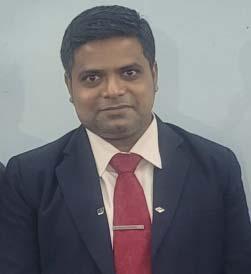
SanjeevikumarPadmanaban receivedhisPhDdegreeinelectricalengineeringfromtheUniversityofBologna,Bologna,Italy,2012.HewasanAssociate ProfessoratVITUniversityfrom2012to2013.In2013,hejoinedtheNational InstituteofTechnology,India,asafacultymember.Then,heservedasan AssociateProfessorwiththeDepartmentofElectricalandElectronicsEngineering,UniversityofJohannesburg,SouthAfrica,from2016to2018.FromMarch 2018toFebruary2021,hewasanAssistantProfessorwiththeDepartmentof EnergyTechnology,AalborgUniversity,Esbjerg,Denmark.Hecontinuedhis activitiesfromMarch2021asanAssociateProfessorwiththeCTIFGlobal Capsule(CGC)Laboratory,AarhusUniversity,Herning,Denmark.Presently, heisaFullProfessorinElectricalPowerEngineeringwiththeDepartmentof ElectricalEngineering,InformationTechnology,andCybernetics,Universityof South-EasternNorway,Norway.HeisafellowoftheInstitutionofEngineers,India,theInstitutionofElectronics andTelecommunicationEngineers,India,andtheInstitutionofEngineeringandTechnology,UK.Heislisted amongtheworld’stoptwoscientists(from2019)byStanfordUniversity,USA.
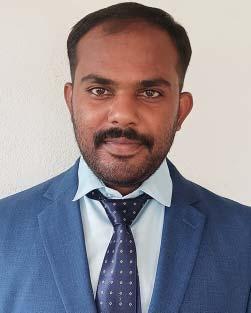
SivaramanPalanisamy wasborninVellalur,MaduraiDistrict,TamilNadu, India.HecompletedschoolinginGovt.HigherSecondarySchool,Vellalur, receivedhisBEinElectricalandElectronicsEngineeringandMEinPower SystemsEngineeringfromAnnaUniversity,Chennai,India,in2012and2014, respectively.Hehasmorethaneightyearsofindustrialexperienceinthefieldof powersystemanalysis,gridcodecompliancestudies,electricvehiclecharging infrastructure,solarPVsystem,windpowerplant,powerqualitystudies,and harmonicassessments.PresentlyheisworkingasaProgramManager–EV charginginfrastructureatWRIIndia(majorcontributiondonebeforejoining thisposition).Heisanexpertinpowersystemsimulationsoftwaresuchas ETAP,PSCAD,DIGSILENTPOWERFACTORY,PSSE,andMATLAB.Heisa workinggroupmemberofvariousIEEEstandardssuchasP2800.2,P2418.5, P1854,andP3001.9.HeisanIEEESeniorMember,aMemberofCIGRE,Life MemberoftheInstitutionofEngineers(India),andTheEuropeanEnergyCenter(EEC).Heisalsoaspeaker whoiswellversedonbothnationalandinternationalstandards.
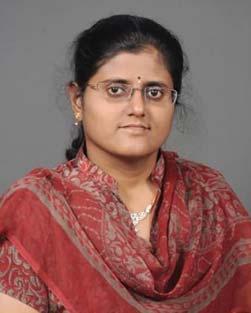
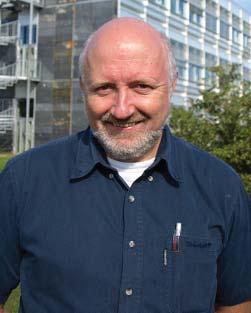
SharmeelaChenniappan holdsaBEinElectricalandElectronicsEngineering,MEinPowerSystemsEngineeringfromAnnamalaiUniversity, Chidambaram,India,andaPhDinElectricalEngineeringfromAnnaUniversity,Chennai,India,in1999,2000,and2009,respectively.ShereceivedherPG DiplomainElectricalEnergyManagementandEnergyAuditfromAnnamalai University,Chidambaramin2010.Atpresent,sheholdsthepostofProfessor intheDepartmentofEEE,CEGcampus,AnnaUniversity,Chennai,India.She hasmorethan21yearsofteaching/researchexperienceandhastaughtvarious subjectstoundergraduateandpostgraduatestudents.Shedidanumberof researchprojectsandconsultancyworkinrenewableenergy,ElectricVehicle ChargingInfrastructure,powerquality,anddesignofPQcompensatorsfor variousindustries.SheisanIEEESeniorMember,aFellowoftheInstitution ofEngineers(India),andaLifeMemberofCBIP,ISTE,andSSI.
JensBoHolm-Nielsen currentlyworksasHeadoftheEsbjergEnergySection attheDepartmentofEnergyTechnology,AalborgUniversity.Throughhis research,hehelpedestablishtheCenterforBioenergyandGreenEngineering in2009andservedastheheadoftheresearchgroup.Hehasvastexperience inthefieldofbiorefineryconceptsandbiogasproduction,inparticular anaerobicdigestion.Hehasimplementedbio-energysystemsprojectsin variousprovincesinDenmarkandEuropeanstates.Heservedasthetechnical advisorformanyindustriesinthisfield.Hehasexecutedmanylarge-scale EuropeanUnionandUnitedNationprojectsinresearchaspectsofbioenergy, biorefineryprocesses,thefullbiogaschain,andgreenengineering.Hewas amemberoninvitationwithvariouscapacitiesincommitteesforover250 variousinternationalconferencesandorganizerofinternationalconferences, workshops,andtrainingprogramsinEurope,CentralAsia,andChina.His focusareasarerenewableenergy,sustainability,andgreenjobsforall.
ListofContributors
AhmedAbbou
DepartmentofElectricalEngineering
MohammedVUniversityinRabat
MohammadiaSchoolofEngineers
Rabat Morocco
ShobhaAgarwal DepartmentofHigherTechnicalEducationandSkill Development
JharkhandUniversity
Ranchi
India
ShariqAhammed PES
ValeoIndiaPrivateLimited
Chennai India
NadiaAwatif DepartmentofElectrical,Electronicand CommunicationEngineering
MilitaryInstituteofScienceandTechnology
Dhaka Bangladesh
GyanR.Biswal
DepartmentofElectricalandElectronicsEngineering VeerSurendraSaiUniversityofTechnology(VSSUT)
Burla
Odisha
India
PhaneendraB.Bobba DepartmentofElectricalandElectronicsEngineering GokarajuRangarajuInstituteofEngineeringand Technology(GRIET)
Hyderabad
India
SatarupaChakrabarti SchoolofComputerEngineering KIITUniversity
Bhubaneswar
India
SohamChakrabarti SchoolofComputerEngineering KIITUniversity
Bhubaneswar
India
RaviChengalvarayanNatarajan DepartmentofElectricalandElectronicsEngineering VidyaJyothiInstituteofTechnology
Hyderabad
Telangana
India
SharmeelaChenniappan DepartmentofElectricalandElectronicsEngineering AnnaUniversity
Chennai
India
KhalidChigane
DepartmentofElectricalEngineering
MohammedVUniversityinRabat
MohammadiaSchoolofEngineers
Rabat
Morocco
MunirajChinnusamy DepartmentofEEE KnowledgeInstituteofTechnology
Salem India
GunapriyaDevarajan DepartmentofEEE
SriEshwarCollegeofEngineering Coimbatore
India
LakshmiDhandapani DepartmentofElectricalandElectronicsEngineering AcademyofMaritimeEducationandTraining (AMET)
Chennai India
SundaramElango DepartmentofElectricalandElectronicsEngineering CoimbatoreInstituteofTechnology Coimbatore
India
ThamatapuEswararao DepartmentofElectricalandElectronicsEngineering CoimbatoreInstituteofTechnology Coimbatore
India
GarikaGantaiahswamy DepartmentofElectricalandElectronicsEngineering JNTUKakinada
AndhraLoyolaInstituteofEngineeringand Technology
Vijayawada AndhraPradesh
India
A.Gayathri DepartmentofEEE
SriKrishnaCollegeofTechnology Coimbatore
TamilNadu
India
Md.SanwarHossain DepartmentofElectricalandElectronicEngineering BangladeshUniversityofBusinessandTechnology
Dhaka
Bangladesh
BouazzaJabri DepartmentofPhysical
LCSLaboratory FacultyofSciences
MohammedVUniversityinRabat
Rabat
Morocco
HamidHajSeyyedJavadi DepartmentofMathematicsandComputerScience
ShahedUniversity
Tehran
Iran
JayakumarNarayanasamy DepartmentofEEE
TheOxfordCollegeofEngineering
Bommanahalli
Bangalore
India
SabareeshwaranKanagaraj DepartmentofEEE
KarpagamInstituteofTechnology Coimbatore
India
KathirvelKaruppazaghi PES
ValeoIndiaPrivateLimited
Chennai
India
MeenakshiDeviManivannan
DepartmentofElectricalandElectronicsEngineering ThiagarajarCollegeofEngineering
Madurai
India
SaadMekhilef PowerElectronicsandRenewableEnergyResearch Laboratory DepartmentofElectricalEngineering UniversityofMalaya KualaLumpur Malaysia and SchoolofScience,ComputingandEngineering Technologies
SwinburneUniversityofTechnology
Hawthorn Vic
Australia and
SmartGridsResearchGroup CenterofResearchExcellenceinRenewableEnergy andPowerSystems KingAbdulazizUniversity Jeddah SaudiArabia
NaveenkumarMarati PES
ValeoIndiaPrivateLimited
Chennai India
MarimuthuMarikannu DepartmentofEEE
SaranathanCollegeofEngineering
Trichy
India
RaniaMoutchou DepartmentofElectricalEngineering MohammedVUniversityinRabat MohammadiaSchoolofEngineers
Rabat
Morocco
GeethanjaliMuthiah DepartmentofElectricalandElectronicsEngineering ThiagarajarCollegeofEngineering
Madurai
India
NageshHalasahalliNagaraju PowerSystemStudies PowerResearch&DevelopmentConsultantsPvtLtd Bengaluru
India
MortezaAzimiNasab CTIFGlobalCapsule DepartmentofBusinessDevelopmentandTechnology AarhusUniversity
Herning
Denmark
MostafaAzimiNasab CTIFGlobalCapsule DepartmentofBusinessDevelopmentandTechnology AarhusUniversity
Herning
Denmark and DepartmentofElectricalandComputerEngineering BoroujerdBranch IslamicAzadUniversity
Boroujerd
Iran
xx ListofContributors
PuspalathaNaveenKumar DepartmentofEEE
SriEshwarCollegeofEngineering Coimbatore
India
FatemehNikokar DepartmentofBusinessDevelopmentandTechnology CTIFGlobalCapsule AarhusUniversity
Herning
Denmark
SanjeevikumarPadmanaban DepartmentofElectricalEngineering,Information Technology,andCybernetics UniversityofSouth-EasternNorway Porsgrunn
Norway
SivaramanPalanisamy WorldResourcesInstitute(WRI)India
Bengaluru
India
MadhuPalati
DepartmentofElectricalandElectronicsEngineering
BMSInstituteofTechnologyandManagement AffiliatedtoVisvesvarayaTechnologicalUniversity DoddaballapurMainRoad,Avalahalli
Yelahanka
Bengaluru
India
P.Pandiyan DepartmentofEEE
KPRInstituteofEngineeringandTechnology Coimbatore
TamilNadu
India
BasantaK.Panigrahi DepartmentofElectricalEngineering InstituteofTechnicalEducation&Research SOAUniversity Bhubaneswar
India
ParanthaganBalasubramanian DepartmentofEEE SaranathanCollegeofEngineering
Trichy
India
Md.I.H.Pathan DepartmentofElectricalandElectronicEngineering HajeeMohammadDaneshScienceandTechnology University
Dinajpur
Bangladesh
SagarSinghPrathap EnergyandPowerSector CenterforStudyofScienceTechnologyandPolicy
Bengaluru
India
ZahiraRahiman DepartmentofElectricalandElectronicsEngineering B.S.AbdurRahmanCrescentInstituteofScience& Technology
Chennai India
MohammadM.Rahman InformationandComputingTechnologyDivision HamadBinKhalifaUniversity CollegeofScienceandEngineering
Doha
Qatar
HemavathiRamadoss DepartmentofElectricalandElectronicsEngineering ThiagarajarCollegeofEngineering
Madurai
India
NishaC.Rani DepartmentofEEE TheOxfordCollegeofEngineering Bommanahalli
Bangalore India
MuhyaddinRawa
SmartGridsResearchGroup
CenterofResearchExcellenceinRenewableEnergy andPowerSystems
KingAbdulazizUniversity
Jeddah
SaudiArabia and DepartmentofElectricalandComputerEngineering FacultyofEngineering
K.A.CAREEnergyResearchandInnovationCenter KingAbdulazizUniversity
Jeddah
SaudiArabia
SalahE.Rhaili
DepartmentofElectricalEngineering
MohammedVUniversityinRabat MohammadiaSchoolofEngineers
Rabat
Morocco
V.Rukkumani DepartmentofEIE SriRamakrishnaEngineeringCollege Coimbatore
TamilNadu
India
SubratSahoo
HitachiEnergyResearch
Vasteras
Sweden
TinaSamavat CTIFGlobalCapsule DepartmentofBusinessDevelopmentandTechnology
AarhusUniversity
Herning
Denmark
S.Saravanan DepartmentofEEE SriKrishnaCollegeofTechnology Coimbatore
TamilNadu
India
Md.Shafiullah KingFahdUniversityofPetroleum&Minerals InterdisciplinaryResearchCenterforRenewable EnergyandPowerSystems
Dhahran
SaudiArabia
MohammadS.Shahriar DepartmentofElectricalEngineering UniversityofHafrAl-Batin
HafrAlBatin
SaudiArabia
LogeshkumarShanmugasundaram DepartmentofElectronicsandCommunication Engineering ChristtheKingEngineeringCollege
Coimbatore
India
MohammadEbrahimShiri MathematicsandComputerScienceDepartment AmirkabirUniversityofTechnology
Tehran
Iran
JyotiShukla DepartmentofElectricalEngineering PoornimaCollegeofEngineering
RTU
Jaipur
India
BrijeshSingh DepartmentofElectricalandElectronicsEngineering KIETGroupofInstitutions
Ghaziabad
India
UmashankarSubramanian RenewableEnergyLaboratory DepartmentofCommunicationsandNetworks PrinceSultanUniversity CollegeofEngineering
Riyadh
SaudiArabia
AleenaSwetapadma SchoolofComputerEngineering KIITUniversity Bhubaneswar
India and RenewableEnergyLaboratory DepartmentofCommunicationsandNetworks PrinceSultanUniversity CollegeofEngineering
Riyadh SaudiArabia
KrishnamohanTatikonda DepartmentofElectricalandElectronicsEngineering JNTUKakinada
AndhraLoyolaInstituteofEngineeringand Technology
Vijayawada AndhraPradesh
India
BalrajVaithilingam PES
ValeoIndiaPrivateLimited
Chennai India
PramilaVallikannan DepartmentofElectricalandElectronicsEngineering B.S.AbdurRahmanCrescentInstituteofScience& Technology
Chennai India
MonikaVardia DepartmentofElectricalEngineering PoornimaCollegeofEngineering
RTU
Jaipur
India
DeviVigneshwariBalasubramanian DepartmentofEEE TheOxfordCollegeofEngineering
Bommanahalli
Bangalore India
VijayalakshmiSubramanian DepartmentofEEE SaranathanCollegeofEngineering
Trichy
India
DeepakYadav PowerElectronicsandRenewableEnergyResearch Laboratory DepartmentofElectricalEngineering UniversityofMalaya KualaLumpur
Malaysia
MohammadZand CTIFGlobalCapsule DepartmentofBusinessDevelopmentandTechnology
AarhusUniversity
Herning
Denmark
IntroductiontoSmartPowerSystems
SivaramanPalanisamy 1 ,ZahiraRahiman 2 ,andSharmeelaChenniappan 3
1 WorldResourcesInstitute(WRI)India,Bengaluru,India
2 DepartmentofElectricalandElectronicsEngineering,B.S.AbdurRahmanCrescentInstituteofScience&Technology,Chennai,India
3 DepartmentofElectricalandElectronicsEngineering,AnnaUniversity,Chennai,India
1.1ProblemsinConventionalPowerSystems
Theconventionalpowersystemisgenerallyclassifiedaspowergeneration,powertransmission,andpowerdistributionsystems.Thepowerisgeneratedfromthermalplants,nuclearplants,orhydroplantsatremotelocations andthisistransmittedtotheloadcenterthroughapowertransmissionsystem[1].Thedistributionsystemis usedtodistributetheelectricpowertovariousend-users.Ithaslimitedcontrolandvisibilityofpowerflowsfrom generationtotheenduser’sload.Someoftheproblemsassociatedwithconventionalsystemsarelimitedvisibilityinpowerflows,limitedcontrol,delayinmeasurementandcontrol,higherenergylossesintransmissionand distributionsystems,poorpowerquality,etc.[2].
1.2DistributedGeneration(DG)
Thedistributedgeneration(DG)isusedtoproducetheelectricpowerclosertotheloadcenterorend-userloads toreducetheenergylossinthetransmissionaswellasdistributionsystemandimprovethevoltageprofile.The sourcesofDGcanbebothrenewableenergysources(likesolar,wind,andfuelcells),andnonrenewableenergy sources(likedieselgenerators).Thesesourcesassimplycalleddistributedenergyresources(DERs)[3].Generally, theseDGsareinterconnectedwiththeprimaryorsecondarydistributionsystemsbasedontheirrating.Figure1.1 showsthesingle-linediagramofa100kWrooftopsolarPVsystemasDGconnectedtothe415V,50Hzsecondary distributionsystem.
Figure1.2showsthesingle-linediagramofa1MWrooftopsolarPVsystemasDGconnectedtothe11kV,50Hz primarydistributionsystem.
TheintermittencyisoneofthemajorchallengesofusingrenewableenergysourcessuchassolarPVandwind energyconversionsystemsasDG.Duetointermittence,theoutputpowerfromthesolarPVsystemandwind energyconversionsystemalsovariesthroughouttheoperationresultinginpowerbalanceandstabilityissues[4]. Theimpactofintermittencycanbereducedtoacertainextentbyusingacomplexsoftwareprogram/tooltopredict theenergyoutputbasedonvarioushistoricaldata.
ArtificialIntelligence-basedSmartPowerSystems,FirstEdition. EditedbySanjeevikumarPadmanaban,SivaramanPalanisamy,SharmeelaChenniappan,andJensBoHolm-Nielsen. ©2023TheInstituteofElectricalandElectronicsEngineers,Inc.Published2023byJohnWiley&Sons,Inc.

SinglelinediagramofarooftopsolarPVsystemconnectedtothesecondarydistributionsystem.
1.3WideAreaMonitoringandControl
Powergridsarethemostcomplicatedandessentialsystemsintoday’slife.Theriskofexperiencingawidevariety offaultsandfailuresisincreasing[5].Theunpredictableandcascadedeventsoffaultsleadtoablackout,andthey haveanimpactonalargerangeofconsumers.Manygridcodesallowthefrequencywithinthespecifiedtolerance limits.Hence,flexibilityinfrequencyleadstounderdrawloroverdrawlofrealpower,aswellasundergeneration oroveragenerationbytheutilities.Thisresultsintheoverloadingoftransmissionlinesandundervoltageorover voltageofthegrid.Also,unpredictability,intermittency,andvariabilityofrenewableenergyintegrationposechallengesingridoperation.ConventionalSupervisoryControlandDataAcquisition(SCADA)systemsarelimited tosteady-statemeasurementsandcannotbeusedforobservingthesystemdynamicsbehavior.Toovercomethe drawbacksofaconventionalsystem,oneofthemostrecentadvancementsinmodernpowergridsiswide-area monitoring(WAM).WiththedevelopmentsofWAM,powersystemdynamicbehaviorismonitoredcloselyin real-time.Sothatthefaultsinthepowergridcanbeidentifiedandprotectedinawiderrange[6].
TheoverallgoalofusingWAMistoimproveprotectionandtodevelopnewprotectionconceptsthatwillmake blackoutslessprobableandmuchlesssevereeveniftheydooccur.ThefollowingarethekeyareaswhereWAM canhelptoprotectpowersystems.
1.Dealingwithlarge-scaleinterruptions
2.Takingtheappropriateprecautionstomitigatetheimpactoffailedsystems
3.Ignoringrelaysettingsthatareincompatiblewiththecurrentsystemconfiguration
4.Achievingareasonablebalancebetweensecurityanddependability

Figure1.2 SinglelinediagramofarooftopsolarPVsystemconnectedtotheprimarydistributionsystem.
Thepurposeofprotectionistosafeguardspecificelementsofthepowersystemaswellasthesecurityofthe powersystemasawhole.
Inthecaseofmainequipmentprotection,WAMplaysasignificantrole.Thisisduetothefactthatprimary protectionmustconsistentlyofferaveryfastresponsetoanyfailureontheelementthatitsafeguards.WAM, ontheotherhand,canbeabeneficialtoolforincreasingsystemperformanceduetotheslowerresponsetime necessaryforbackupprotectionandthefactthatitprotectsazoneofthesystem.Wide-areameasurementshave thepotentialtoenablethedevelopmentofsupervisorymethodsforbackupprotection,morecomplextypesof systemprotection,andaltogethernewprotectionconcepts.Examplesoftheseprotectionfunctionsare
1.Dynamicrelaysadjusttheirparametersinresponsetochangesinthesystemcondition.
2.Multiterminallineprotectionhasbeenimproved.
3.Predictiveend-of-lineprotection,whichmonitorsthedistantlocationbreakerandreplacestheunder-reaching Zone1withaninstantaneouscharacteristicifitisopen.
4.Modifyrelaysettingstemporarilytopreventmalfunctionduringcoldloadpickup.
5.Employthecapabilityofmodernrelaystoself-monitortofindhiddenfaultsandusetheIEC61850hot-swap capabilitiestoeliminatethem.
6.Artificialcontrolledmicrogridsprovideanadaptivecontrolleddivergencetopreventanuncontrolledsystem separation.
WAMgathersdatafromremoteplacesthroughoutthepowergridandintegratestheminreal-timeintoasingle snapshotofthepowersystemforagiventime.Synchronizedmeasurementtechnology(SMT)isacrucialcomponentofWAMbecauseitallowsmeasurementstobecorrectlytimestamped,typicallyusingglobalpositioning system(GPS)timingsignals.Thedatamaybesimplymergedwiththesetimestamps,andphaseanglemeasurementscanbemadewithacommonreference[7].Figure1.3showsthegenericWAMSarchitecturebasedonphasor measurementunits(PMUs).PMUs,phasordataconcentrators(PDCs),communicationnetworks,datastorage, andapplicationsoftwarearetheprimarycomponentsofWAM.ThenumberofsubstationPDCsisdetermined
Figure1.3 Blockdiagramofwide-areamonitoringand control.
Transmission system
Distribution system
Customers
bythepowersystemrequirements.Voltage,current,andfrequencyaremeasuredbyPMUsplacedinsubstations. ThesereadingsareroutedstraighttothecentralPDCorasubstationPDC. ThefollowingfunctionsareavailableatthePDCsubstation:
✓ Synchronizationofdateandtime
✓ GathersinfofromPMUs
✓ Analyzescollecteddata
✓ DataissenttothecentralPDC
✓ CommunicatesdatawiththeregionalSCADA
✓ Dataisarchivedlocally
✓ Carriesoutlocaldataanalysisandsecurityactions
1.4AutomaticMeteringInfrastructure
ThenameAdvancedMeteringInfrastructureorsimplyAMIreferstotheentireinfrastructure,whichincludes everythingfromsmartmeterstotwo-waycommunicationnetworkstocontrolcenterequipment,aswellasall theapplicationsthatallowforthegatheringandtransferofenergyusagedatainreal-time.Thebackboneofthe smartgrid[8]isAMI,whichenablestwo-wayconnectivitywithcustomers.Error-freemeterreadingfromremote, networkproblemanditsdiagnosis,loadprofile/patterns,energyaudits/consumptions,andpartialloadcurtailmentinplaceofloadsheddingareallpotentialobjectivesofAMI.ThetypicalbuildingblocksofAMIareshown inFigure1.4.
AMIismadeupofseveralhardwareandsoftwarecomponentsthatallworktogethertomeasureenergyconsumptionandsenddataaboutittoutilitycompaniesandcustomers[8].Thekeytechnologicalcomponentsof AMIare,
◽ SmartMeters:Advancedmeterdevicesthatcouldgatherdataofelectricalparametersatvariousintervals andtransferthedatatotheutilityviafixedcommunicationnetworks,aswellasreceivinginformationfrom theutilitysuchaspricingsignalsandrelayingittotheconsumer[9].
Figure1.4 BasicbuildingblocksofAMI.
• CommunicationNetwork:Smartmeterscanprovidedatatoutilitycompaniesandviceversa.The advancedcommunicationnetworksallowtwo-waycommunicationbetweensmartmetersandutilitycompanies.Fortheseapplications,networkslikeBroadbandoverPowerline(BPL),PowerLineCommunications (PLC),FiberOpticCommunication,FixedRadioFrequency(RF),orpublicnetworks(e.g.landline,cellular, paging)areused[10].
• MeterDataAcquisitionSystem:Dataiscollectedfromsmartmetersoveracommunicationnetworkand senttothemeterdatamanagementsystem(MDMS)usingsoftwareapplicationsontheControlCentrehardwareandDCUs(DataConcentratorUnits).
MDMSMetering:receivestheinformation,storesit,andanalyzeditbythehostsystem.
◽ HomeAreaNetwork(HAN):Itcanbeaconsumer-sideextensionofAMI,allowingforeasiercommunication betweenhouseholdappliancesandAMI,andthusbetterloadcontrolbyboththeutilityandtheconsumer[11].
ThebenefitsofAMIaremultifoldandcanbegenerallycategorizedasfollows:
OperationalBenefits:TheentiresystembenefitsfromAMIsinceitimprovesmeterreadingaccuracy,detects energytheft,andrespondstopoweroutageswhileremovingtheneedforanon-sitemeterreading.
FinancialBenefits:UtilitycompaniesfinanciallybenefitfromAMIbecauseitlowersequipmentandmaintenancecosts,enablesfasterrestorationofelectricserviceduringoutages,andstreamlinesthebillingprocess.
CustomerBenefits:ElectriccustomersbenefitfromAMIbecauseitdetectsmeterfaultsearly,allowsforspeedierservicerestoration,andimprovesbillingaccuracyandflexibility.AMIalsoofferstime-basedtariffchoices, whichcanhelpconsumerssavemoneyandbettermanagetheirenergyusage.
SecurityBenefits:AMItechnologyallowsforbettermonitoringofsystemresources,reducingtheriskof cyber-terroristnetworksposingathreattothegrid.
Inspiteofvariousadvantages,AMIdeploymentfacesthreesignificantchallenges:highercapitalcostsorinvestments,connectionorinteroperabilitywithothergridsystems,andstandardization.
HighCapitalCosts:Afull-scaleimplementationofAMInecessitatesinvestmentsinallhardwareandsoftware components,includingsmartmeters,networkinfrastructures,andnetworkmanagementsoftware,aswellas costsassociatedwithmeterinstallationandmaintenance.
Integration: CustomerInformationSystems(CISs),GeographicalInformationSystems(GISs),OutageManagementSystems(OMSs),WorkManagementSystem(WMS),MobileWorkforceManagement(MWM), SCADA/DMS,DistributionAutomationSystem(DAS),andotherutilities’informationtechnologysystems essentiallyintegratedwithAMI.
Standardization:Compatibilitystandardsmustbecreated,astheyarethekeystoproperlyconnectingand sustaininganAMI-basedgridsystem.TheysetuniversalrequirementsforAMItechnology,deployment,and generaloperations.
InvestinginAMItomodernizethepowergridsystemwillalleviateseveralgridstressescausedbytherising powerdemands.AMIwillimprovethreecriticalaspectsofpowergridinfrastructuresuchassystemreliability, energycost,andelectricitytheft.
SystemReliability:AMItechnologyincreaseselectricitydistributionandoveralldependabilitybyallowingelectricitydistributorstoidentifyandrespondtoelectricdemandautomatically,reducingpoweroutages.
EnergyCosts:Increasedstabilityandfunctionality,aswellasfewerpoweroutagesandstreamlinedbillingoperations,willgreatlyreducetheexpensesinvolvedwithprovidingandmaintainingthegrid,resultinginsignificantlycheaperelectricitybills.
ElectricityTheft:ElectricitytheftisaprevalentprobleminSociety.AMIsystemsthattrackenergyusagewillaid inmonitoringpowerinreal-time,resultinginenhancedsystemtransparency.
1.5PhasorMeasurementUnit
AphasormeasurementunitorsimplyPMUisacrucialmeasurementtoolthatisusedonelectricpowersystems toimprovegridoperators’visibilityonthehugepowergridnetwork/system[12].Itmeasurestheparametercalled aphasoranditprovidestheinformation/dataofmagnitudeandphaseangleofvoltageorcurrentataparticular location[13].Thisinformation/datashallbeusedtofindtheoperatingfrequencyataparticulartimeinstantand examinetheconditionofthesystemasshowninFigure1.5.
APMUmayprovideupto60measurementspersecond.AscomparedwithatypicalSCADA-basedsystem,the measurementspersecondarehigherinPMU.AtypicalSCADA-basedsystemwillprovidethedata(onemeasurementdataintwotofoursecondstimeinterval)[14].ThemainadvantageofusingPMUoverconventionalSCADA systemisPMUcancollectthedataofallPMUataparticulartimethroughGPS.Thismeans,thatcollecteddata acrossthepowergridaretime-synchronized.Becauseofthisreason,PMUsarealsocalledsynchrophasors[15].
TheinformationcollectedfromthePMUconveystothesystemoperatorwhetherthemainelectricalparameters suchasvoltage,current,andfrequencyarewithinthespecifiedlimitwithtoleranceornot.Thecapabilityofthe PMUisasfollows,
◾ Linecongestion:prediction,analysis,andmanage
◾ Analyzingtheeventafterthedisturbanceorfault(postfaultanalysis)
◾ Instabilityandstressdetection
◾ Inefficienciesdetection
Inthisdecade,severalthousandsofPMUsaresuccessfullyinstalledandcommissionedintransmissionand/or distributiongridsacrosstheglobe.APMUcanbeintegratedwithsmartcontrollers,andthiswillreducethemanualoperationsrequiredbytheSCADAsystemindecisionmakingandcontrol.Duetothisfeature,thegridbecomes robustandefficient,itallowsthemoreintegrationofrenewablepowers,DERs,andmicrogrids.
ThereportonUnifiedReal-TimeDynamicStateMeasurement(URTDSM)byPowerGridCorporationofIndia Ltd.(PGCIL)showstheimportanceofPMUdata(datafromvariouslinesattime-stamped)isusefulforprediction andpostfaulteventanalysis.PGCILfollowedthephilosophystatedbelowforinstallingthePMUsacrossIndia, installationofPMUsonsubstationsat400kVlevelabove,allgeneratingstationsat220kVlevelandabove,HVDC terminals,importantinter-regionalconnectionpoints,inter-nationalconnectionpoints,etc.Also,theprovision ofPDCatallStateLoadDispatchCenters(SLDCs),RegionalLoadDispatchCenters(RLDCs),andNationalLoad DispatchCenter(NLDC)[7].
ThePMUisusedtomeasurethemagnitudeandphaseangleofbusvoltageandlinecurrentphasor.PMUtakes thebusPTinputforvoltageandlineCTinputforcurrentatthesubstationaswellasGPStimesignal.ThePMU presentlyavailableinthemarketcanmeasureonesetofbusvoltage(three-phase)andtwosetsoflinecurrent (three-phase).ThetypicalarrangementofPMUinsubstationandMainPhasorDataConcentrator(MPDC)/Sub PhasorDataConcentrator(SPDC)inloaddispatchcenterisshowninFigure1.6[7].
Figure1.5 Transmissionlinedata.
Figure1.6 TypicalarrangementofPMUinsubstationandPDCintheloaddispatchcenter.
ThePMUoutputfromthesubstationiscommunicatedtoPDCthroughaLocalAreaNetwork(LAN)switch androuter.APDCattheloaddispatchcenterisusedtoreceivethedatafromthemultiplePMUsofdifferent substations.Also,PDCcommunicateswithotherPDCsandtransfersthedata.ThePDCsalign/storethePMU databythetime-stampedlabelandcreatethetime-synchronizeddataset.AllthePDCsareconnectedlocallywith computers/hostworkstations,printers,andoperators’cabinetsviaEthernet.
